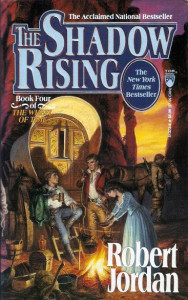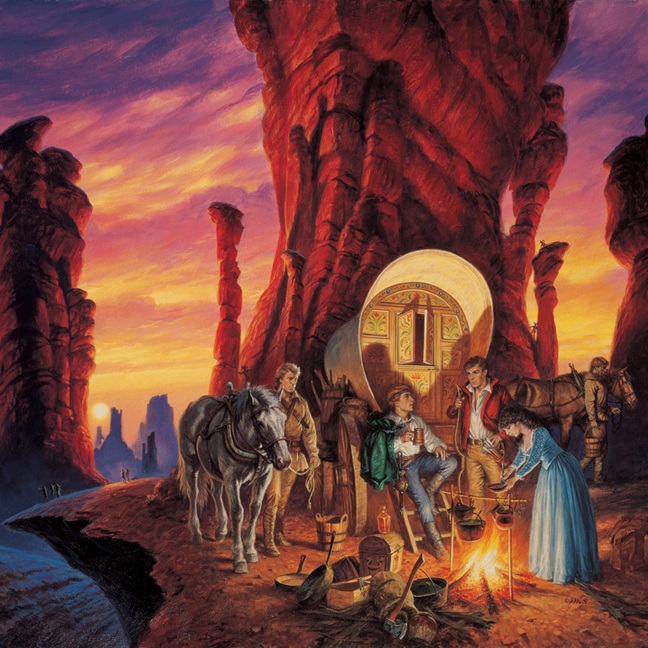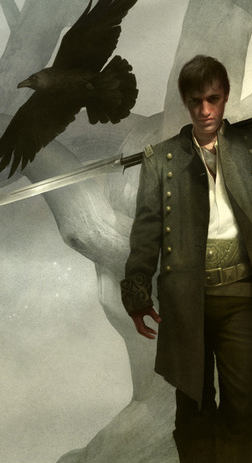
In my last commentary, I commented about how one of the major reasons why I decided to do these re-reading projects was to learn more about myself as a reader and critic and to explore how my takes on various novels had changed over an intervening period of several years. For the first three Wheel of Time novels, my overall attitude had shifted only slightly. I still liked the first book, The Eye of the World, better than the second and third volumes, The Great Hunt and The Dragon Reborn. What I liked and why, however, had changed, sometimes drastically.
In particular, I found even the first three volumes to contain several annoying features. Among them, average, pedestrian prose, laziness in using quirks and invented stereotypes to describe characters and imagined cultures, and the beginnings of what author/critic Adam Roberts has referred to as “decor-porn.” Despite these annoying narrative features, I was able to enjoy those three volumes as long as I focused on viewing the books as a sort of quest narrative. If I had devoted more time to looking at the numerous “prophecies” and their ilk and tried to predict as-yet-untold events rather than concentrating on the story at hand, I suspect I would have grown bored quicker than I have.
[A] Frankenstein’s monster that contains more splitting narratives and fewer resolutions than was found in the first three volumes.
The fourth volume, The Shadow Rising, marks a pivotal change in the Wheel of Time series. This is the place where, for better or for worse (and I’m more inclined to say for the worse), Jordan decides to expand the narrative beyond what had first appeared to be a bog-standard epic fantasy quest to defeat the heinous forces of EVIL. It is here where elements of court intrigue and political manipulation are grafted onto the original quest narrative tree. The resulting mixture is a nearly 1000 page (MMPB) Frankenstein’s monster that contains more splitting narratives and fewer resolutions than was found in the first three volumes.

When I first read this book back in November 1997, it took me a while to get into the story, largely because there are nearly 300 pages of setup and awkward character interactions before the young folk gathered in the Stone of Tear split into three groups to go on their not-quite-so-merry ways. I have remarked before on the unfortunate tendency of Jordan to overdescribe his characters and settings. I found this to be the case this time through, almost to the point of me being tempted to skip whole sections and even chapters. That old adage of sometimes less being more fits this series and particularly this novel nicely.
Perhaps it is due to my advancing age, but at 35, I found myself not relating to these characters as much as I perhaps had done (to a degree, that is) when I was barely 23. A sniff here, a puzzled frown there, all sorts of confusions about what the other gender might mean by their comments and gestures. While doubtless this was intentional in part, perhaps to try for a sort of comedy of manners routine, the repetitiveness in the types of responses to these situations quickly made those exchanges tedious to read. Although the frequency decreased after the characters split up to go on their own subplot ways, it still left me asking myself if I were reading some sort of bad reworking of Sweet Valley High in an epic fantasy setting. Maybe there is indeed something to the belief that people will interpret events differently as they age.
 Besides the love trysts and sniffs, the dialogue was at best serviceable and at worst, utterly atrocious. Jordan rarely is considered to be an even average prose stylist, but in this book, with its attempts to cover four subplots (the three branching off from the Stone of Tear and the other from the Aes Sedai stronghold of Tar Valon), most everything felt forced. The scenes in the rural Two Rivers district, where the three main male characters were raised, felt at times as if I were reading a sort of fantasy Braveheart, with the appearance of an unlikely leader, Perrin, to rally the villagers to protect their homes. Although I can understand why many readers would enjoy such scenes (the excitement, the fighting, the feel-good ending), it just didn’t work well for me at the end. It just felt clichéd in its approach toward both Hero (Perrin) and villagers and the author’s decision to have large chapter chunks devoted to the four separate subplots often left too much of a space between developments in these subplots. The Perrin subplot in particular suffered from this herky-jerkiness in the switching from locale to locale.
Besides the love trysts and sniffs, the dialogue was at best serviceable and at worst, utterly atrocious. Jordan rarely is considered to be an even average prose stylist, but in this book, with its attempts to cover four subplots (the three branching off from the Stone of Tear and the other from the Aes Sedai stronghold of Tar Valon), most everything felt forced. The scenes in the rural Two Rivers district, where the three main male characters were raised, felt at times as if I were reading a sort of fantasy Braveheart, with the appearance of an unlikely leader, Perrin, to rally the villagers to protect their homes. Although I can understand why many readers would enjoy such scenes (the excitement, the fighting, the feel-good ending), it just didn’t work well for me at the end. It just felt clichéd in its approach toward both Hero (Perrin) and villagers and the author’s decision to have large chapter chunks devoted to the four separate subplots often left too much of a space between developments in these subplots. The Perrin subplot in particular suffered from this herky-jerkiness in the switching from locale to locale.
[It] felt at times as if I were reading a sort of fantasy Braveheart.
The main subplot, that of Rand’s journey into the Aiel wastelands, was better done. For those readers who prefer to immerse themselves in an author’s imagined setting and “history,” the chapters devoted to Rand’s discovery of who his ancestors were and why the Aiel were where they were doubtless were major draws. Although at times I thought the made-up history lessons were a bit much, they do serve to set up so much of what happens afterward when Rand is proclaimed the Car’a’carn, or Chief of Chiefs (but not the God of Thunder and Rock’n’Roll, although considering a pivotal scene late in the novel, even that august title could have been applied to him). This was perhaps the best subplot in the novel and maybe even in the series to date, although it too was weakened somewhat by the need to switch to the other subplots.
The third subplot involving one of Rand’s squeezes, the princess/Daughter-Heir Elayne and the former Two Rivers Wisdom Nynaeve (I want to pronounce her name as “naive,” but it’s NY-nehve, or something like that) felt more like a Scooby Doo mystery investigation or perhaps a Nancy Drew comparison might be more apt. They are off to the west coast to catch some waves and to track down the 11 missing members of the EVIL Black Ajah, the quasi-secret part of the Aes Sedai who worship the Dark Side. This subplot was weaker than the first two, not just because of the fissured narrative, but also because it felt much less complete than the other two. Yes, they accomplish part of their task, but the lack of a true resolution left this subplot feeling more as though it had ended in the middle rather than pausing at an appropriate point.
For those who like a limited number of subplots and PoV characters, this book may be slightly frustrating.
The final subplot, the barely discussed White Tower one involving the second of Rand’s ladies, Min, and the Aes Sedai, perhaps should have been left out of this novel altogether, as less than a handful of chapters were devoted to narrating Min’s arrival and the subsequent division of the White Tower. I suspect this could have been shifted over to the fifth book and a more complete narrative could have been established there. As it stands, these chapters were quite annoying, as they basically served to break up the flow of reading one of the other subplots.
When I finally finished this mammoth book, I found myself musing that the overall effect was much less than I had recalled it being. In the decade-long interim between my reads of this book, I have shifted away from being someone who reads just for content and more toward a reader who values style and presentation just as much. For readers who want to read an epic fantasy mostly to lose one’s self in the created history and perhaps in the speculations that can be generated from “prophecy” foreshadowings, The Shadow Rising may be like manna from heaven. For those who like a limited number of subplots and PoV characters, this book may be slightly frustrating. For those, such as myself, who want well-presented prose and dynamic, well-drawn characters, this book probably will be a disappointment. But I soldier on, fearing the Circus scene that I vaguely recall being in the next volume, The Fires of Heaven.


hats off to you for re reading the series!!!
i haven’t read them and don’t plan to. They are far too massive and, going by the reviews, too slow in the middle. I also have this image about this series which is difficult to shake off.
And i don’t think Jordan will find many new readers to take to the book. But those who do, i wish them all the best!! May they have a fun experience!